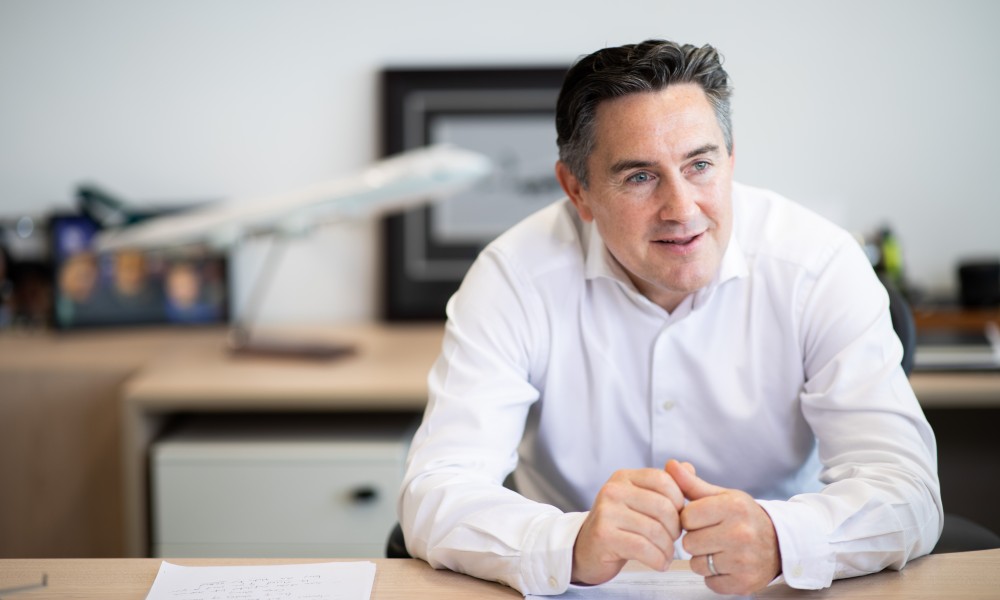What are your thoughts about the past year?
Well, Cathay Pacific’s 75th year was certainly historic and unprecedented. 2020 had, of course, also been extraordinary with the first impacts of the pandemic and the subsequent PPE boom, but even then it’s fair to say nothing really prepared us for 2021. It was a year characterised by uncertainties and operational challenges. Clearly the disruptions due to the Boeing 747 pilot quarantine issues back in Q1 and Q2 were very significant, and further reduced our freighter capacity. That was a very difficult period, because demand was increasing, but we couldn’t fulfil it. This year has started in a similar vein.
What were the main challenges for Cathay Pacific Cargo last year?
They fall under two linked areas – the effects of the pandemic and restrictions, and the consequent tightening of the supply chain. In terms of COVID-19, we have had to factor in extra processes, such as contactless aircrew transfers and disinfecting regimes in aircraft and warehouses; meanwhile our pilots have faced ever-changing restrictions, which has created constant uncertainty around our schedule. We owe our cockpit crews a huge debt of gratitude for keeping things going across the airline by signing up to the closed-loop roster pattern for our freighter operations. On the passenger side, our pilots have also operated close to 8,000 cargo-only passenger flights.
What have been the latest developments at the start of this year?
Unfortunately, the pandemic continues to pose major challenges for our teams and our customers. COVID-19 itself has created so many uncertainties for our people everywhere. Different parts of the world had outbreaks at different times, and our teams have all been affected, either personally or by the difficulties of working through this period.
At the very end of 2021, the Hong Kong SAR Government introduced more stringent quarantine requirements for our air crew. We are fully supportive of the Hong Kong SAR Government’s efforts to keep COVID-19 infections in the community down and we also want to keep Hong Kong as connected as possible. We temporarily suspended our long-haul freighter and cargo-only passenger flights to allow us to rebuild a deliverable, albeit reduced, schedule to keep as much capacity as we were able for the start of the year. While we have a full regional service, we have had to reduce the frequency of our long-haul freighter flights, and we can only offer sincere apologies for the disruption this will cause our customers. We will look at all avenues to increase capacity, but they will depend on finding effective ways to roster our crews. We will keep you updated as the first quarter moves on.

What were the commercial impacts?
On the one hand, it’s a strong market. But on the other, due to disruptions in the first half of 2021 we had to reduce contracted space. This was a big issue, because we couldn’t give our customers the space they wanted in the first half of the year. We then had to apply a rate increase on BSAs on certain lanes in the second half of the year as the pandemic prolonged the constraints on our capacity. But we remain committed to supporting our customers and working together to overcome obstacles.
How is the market now?
The supply-demand dynamic is in our favour and there’s clearly a very strong demand recovery around the world. The fact that supply chains are tighter means the cost disparities between sea and air have lessened. We’ve had good charter demand, and our teams have been able to ‘turn on’ new ports quickly. On the flip side, our Hong Kong market share is down on 2019 because of the lack of capacity.
Have there been things to celebrate in the past year?
Yes. Despite the challenges, we have achieved a lot commercially and operationally. We have introduced our Vaccine Solution, launched Ultra Track and we have digitalised our pricing to enable the recent launch of our online booking platform Click & Ship. We have been accredited with IATA’s CEIV Live Animals and we’re offering our customers new container options, including fire-resistant containers for the safe transport of lithium-ion batteries. Our overall digitalisation programme is making us more agile and we are starting to use data to improve our performance. And the awards we picked up towards the end of the year reflect industry appreciation of our efforts.

Does this mean you are underway to achieving your brand vision?
We have made a strong start towards our vision to become ‘the world’s most customer-centric air cargo service brand’ and there is more to come in 2022. We’ve said that we want to set ourselves apart from our competitors with four differentiators – expertise, quality, innovation and people – but now we will also be seeing things through the lens of six focus areas:
-
Hong Kong Hub and the Greater Bay Area (GBA) market development
-
Brand and marketing strength
-
Customer solutions and service excellence
-
E-commerce growth
-
Digitisation and automation
-
Future fleet and network
What will these key areas mean?
These are not ‘business as usual’ items. These are areas we need to get organised, get right and invest in. Although the market is strong now, we know that the cargo business is cyclical, so we need to prepare ourselves. These six key areas are what we think will ensure Cathay Pacific Cargo remains strong and relevant in our markets.
The focus on the Hong Kong hub and the GBA is about rebuilding our market share post-pandemic, and ensuring that Hong Kong maintains its strength as a logistics hub – particularly with the new third runway to come. For the GBA, it’s around making sure we are taking advantage of new multi-modal sea-to-air opportunities as they develop.
We need to keep offering the products and solutions that our customers want, and there is more to come on that this year. On the services side, it’s about focusing on the end-to-end product delivery and developing a more effective feedback loop so that we can analyse the data and improve. We’ve seen a lot of progress internally about our digitalisation journey, as well as some major developments that our customers will have seen, such as Ultra Track and Click & Ship. Coming up, there will be developments on these based on feedback from our customers, plus a few new launches.
We also want to make sure that we don’t miss out on opportunities to carry additional e-commerce, which is still a growing market, and we want to make sure we’re doing it in the right way as the market continues to grow.
This is about assessing what we need over the next few years in terms of fleet, to ensure we grow and maintain relevance. We’ll also look at sustainability, which is becoming of increasing importance for shippers, and at what we can achieve with sustainable aviation fuel and carbon offsetting.
What’s your message for this year?
Competitors continue to invest and grow. Clearly, many more carriers have now got a focus on cargo, so it’s very important that we continue to grow and achieve our vision in the face of greater competition. One thing I’m certain of is that no matter what this year throws at us, we will continue to deliver the best quality of service to our customers.








